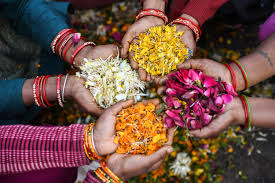Light From Plight Of Flowers
Ajay Singh Rawat/ December 9, 2020

.
Flowers in nature
Flowers are the natural ornaments of a plant. A flower registers its presence in an environment by every aspect of its entity. Its beauty, fragrance, nectar, and tenderness lure all of our four senses of sight, smell, taste, and touch.
.
A glimpse of a pond with lotus bloomed, a bumblebee or honeybee hovering over a flower, dew-covered petals, the intoxicating fragrance of night-blooming jessamine, flowers swaying in the breeze, the celebrated love of Kamalini (lotus) with sun and Kumudini (water lily) with the moon, all mesmerize us.
.
Human love for flowers
For humans, flowers epitomize beauty, delicacy, chastity, innocence, love, honor, and devotion. Kalidas describes Shakuntala as an un-smelled flower in his famous creation Abhijnanasakuntalam.
.
The deity of love Kamadeva is equipped with a bow and arrow of flowers and is therefore called “Pushpadhanwa.” Spring, when flowers blossom, is celebrated as the season of love in Indian culture. The festival of love, Holi, in olden times was celebrated with colors prepared from flowers.
.
Many of the flowers’ names are popular as human names as well like Juhi, Champa, Chameli, Kamal, Pankaj, Neeraj, Malti, Mallika, Kumudini, Madhavi, Padmini, Nalini, Bela, Palash, Parijat, Shefali, Nargis… the list is indeed long enough.
.
The fondness for flowers is not confined to humans only. It levitates up to their deities too. Some gods are supposed to have their favorite flowers as well. Jasmine is dear to Hanuman, Palash to Saraswathi, marigold to Ganesh, lotus to Laxmi, Parijatham to Vishnu, red hibiscus to Goddess Kali, crown flower to Shiv, Kadamba to Krishna and Murugan.
.
Occasional use of flowers in human culture
Multiple occasions in human life are graced with flowers. Human emotions suitably find their expression through them. They are offered to god. Lovers gift it to their beloveds, women like to adorn their hair with them. Flowers add fragrance and vivid colors to their surroundings. Unwell people cheer up when greeted with flowers. The exchange of garlands is a Hindu marriage ritual. Flower petals are showered on winners. People are welcomed with garlands. People, when they pass away, are bid farewell with flowers.
.
Destiny of flowers
Blooming and withering are quite natural for flowers. But after so much adoration they get in our culture and society, it is painful to see them dumped, especially at places like temples where they arrive in large volumes.
.
Harms of floral waste
Flowers are biodegradable by nature. So, people wrongly assume that they won’t pollute the environment. The awareness regarding proper disposal of floral waste is therefore not widespread.
.
Floral waste from temples is mostly dumped into nearby rivers, ponds, and lakes. The sacredness attached to them is behind this act. In renowned religious places, the quantity is very high. When such an enormous mass is disposed of in river water, it becomes a consistent source of pollution to them. The oxygen levels of these water bodies deplete, thereby suffocating the fragile aquatic life. The lack of any monitoring system worsens the matter.
.
Seeing a creation of nature polluting the environment to which it once added beauty is appalling.
.
The innovative idea of floral recycling
Recycling is making something out of a mess. Well-employed people are not likely to mess up with this idea. But Rohit Pratap Singh, an engineer from Haryana, is among those few people in India who were intrigued by the thought of floral recycling. He left his well-paid job in 2018 and plunged into it.
.
A six months’ research on the process to recycle flowers with some trials and errors resulted in the preparation of some products. He supplied them to friends and relatives. He garnered an overwhelming response that prompted him to set out on a path less trodden though strewn with withered flowers only.
.
Recycling of floral waste
The recycling of flowers is not as pleasant as their gardening. For a novice entrepreneur, it was not easy to procure bedraggled flowers at temples. Initially, the curious sight of passers-by while he was collecting dumped flowers made him uncomfortable. Many people just did not realize the greatness of his work. He outgrew these things.
.
Rohit has installed 50-100 kg capacity containers at twelve temple premises of Rishikesh and two ghats. They get as much as 500 kg of flower waste daily.
.
The floral waste they receive includes different kinds of flowers, fresh, semi-fresh, and withered. After judiciously segregated, the flower petals are spread out to sun-dry in a clean open area.
.
The dried material is then powdered, perfumed, mixed with natural resins, and prepared into a dough that is finally hand-rolled into incense sticks.
.
One kg flower waste provides 70-80 g of powder. They prepare 1000 packets of incense sticks daily.
.
Their incense stick is an eco-friendly alternative of charcoal-based incense sticks available in the market. It leverages on floral refuse. It is handcrafted and excluded as an organic product.
.
Besides incense sticks, they prepare gulal, vermicompost, shower gel. Now they are planning to prepare havan material, lip gloss, face pack as well.
.
Flower recycling as a social enterprise
.
Rohit Pratap Singh has come a long way from where he started. The business he started with Rs. 10 lakh is now yielding him a monthly income of Rs 2 lakhs. He has carved a niche for himself in India’s bioeconomy.
.
It is not only the flowers that transform from recycling, lives of the women from underprivileged sections of society, who are employed in this process, transform too. Financially independent, they can make both ends meet now.
.
Why should we buy these products?
.
Recycling is the silver lining in a culture ridden with consumerism. We can lend our support to people who are aiming at responsible consumerism.
.
The recycled incense sticks imbibe the souls of flowers in a new form and allow them to present in the holy service once again. The fragrant smoke wafting from them seems to translate into the famous shloka of Gita that holds true for them too:
.
वासांसि जीर्णानि यथा विहाय नवानि गृह्णाति नरोऽपराणि।
तथा शरीराणि विहाय जीर्णा न्यन्यानि संयाति नवानि देही।।
.
As a person sheds worn-out garments and wears new ones, likewise, at the time of death, the soul casts off its worn-out body and enters a new one.
Recent Comments